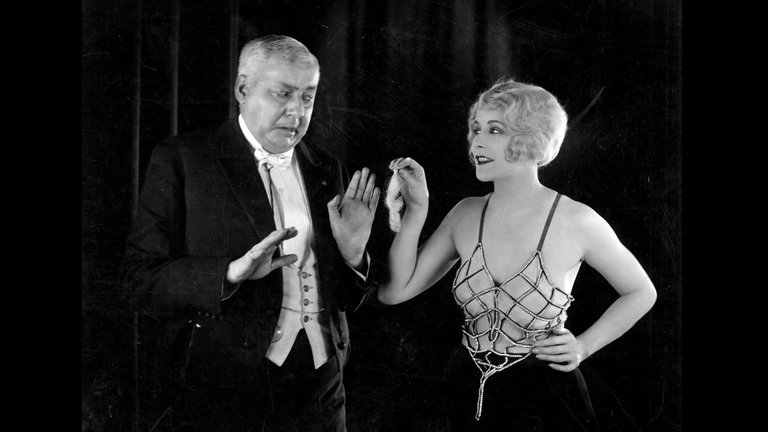Film Review: The Pleasure Garden (1925)

If you are a young filmmaker, it’s not very likely that you will repeat Orson Welles’ achievement and have your feature directorial debut hailed as an undisputed masterpiece. In fact, you should consider yourself quite fortunate if your debut turns out merely good. Such statistics can work even against celebrated geniuses of world cinema like Alfred Hitchcock, at least judging by his first film, the 1925 British silent melodrama The Pleasure Garden.
The film is based on the novel by Marguerite Florence Laura Jarvis, written under the pen name “Oliver Sandys”. The plot begins in London when aspiring dancer Jill Cheyne (played by Carmelita Geraghty) comes to take a job at the Pleasure Garden Theatre. Her letter of introduction and all her money have been snatched by a pickpocket. Seeing her plight, kind-hearted chorus girl Patsy Brand (played by Virginia Valli) takes her in as her roommate, and Jill is hired by theatre owner Mr. Oscar Hamilton (played by Georg H. Schnell, credited as “George Snell”). Jill is later visited by her fiancé Hugh Fielding (played by John Stuart), who is about to go to work in the British colonies. Hugh’s best friend and co-worker Levet (played by Miles Mander) is introduced to Patsy and decides to marry her before joining Hugh. The two young women react to the absence of their love interests differently – Patsy patiently awaits Levet’s return, while Jill uses her charm to seduce rich and influential patrons of her theatre, including Prince Ivan (played by Karl Falkenberg), who would make her his kept woman. After learning that her husband has become ill, Patsy decides to travel and join him. While Jill refuses to help, Patsy’s kind-heartedness leads her to borrow money. Upon arrival, Patsy finds that Levet is actually healthy and has taken a native girl (played by Elizabeth Pappritz) as his mistress. Enraged, she decides to tend to Hugh, who is actually sick, but Levet reacts by murdering his girlfriend and then abducting Patsy.
By the mid-1920s, young Hitchcock had already gained a lot of experience working various jobs in the British film industry. The Pleasure Garden was actually his third film. Number 13, his first directorial effort, was only partially shot in 1922 before being abandoned due to poor finances. The 1923 short comedy Always Tell Your Wife is now considered lost. The Pleasure Garden was commissioned by Michael Balcon, producer and co-founder of Gainsborough Pictures, one of the early powerhouses of British cinema. Balcon gave Hitchcock the opportunity to direct and, more importantly, made it in co-production with Bavaria Film, one of the German studios that provided facilities in Munich and parts of the cast. Hitchcock had already been in Germany, working on various co-productions and, among other things, using the opportunity to observe F. W. Murnau direct the groundbreaking drama The Last Laugh, an experience that left a lasting impression on the British filmmaker and deeply influenced his work.
All that, however, failed to reflect on The Pleasure Garden, which actually flopped at the box office and, despite a few positive reviews, was not considered remarkable at the time. Hitchcock was still developing his style, and at least at first glance, this film looks indistinguishable from many similar melodramas produced in the silent era. The script by Eliot Stannard features an extremely simple plot and even simpler characterisation, with American actresses Virginia Valli and Carmelita Geraghty playing archetypal Good and Bad Girls, while Miles Mander, who would later achieve a career as a prolific character actor in Hollywood, does a solid job with his poorly written character. The film suffers from a somewhat slow pace in the beginning, only to be interrupted by almost irrational levels of violence and abrupt deus ex machina that would later plague many of Hitchcock’s better-known or more iconic thrillers. Hitchcock admirers and scholars would nevertheless have some fun discovering some of his early trademarks – innovative shots and visual tricks, an obsession with blondes (although both female protagonists are brunettes), and even some mild eroticism. This includes Elizabeth Pappritz wearing conveniently skimpy clothes and being murdered in a manner that would, in certain ways, resemble similar scenes in later classics of exploitation cinema, slasher films, and even Hitchcock’s own Psycho. Hitchcock wasn’t particularly pleased with the film, although the production, during which his fiancée and future wife Alma Reville served as his assistant director, included the use of scenic Italian locations at Lake Como. Despite the flaws of his debut, Hitchcock left a sufficiently good impression to continue his career with The Mountain Eagle, another silent film produced in Germany, which became lost, and The Lodger, which would become his first “proper” thriller.
RATING: 5/10 (++)
Blog in Croatian https://draxblog.com
Blog in English https://draxreview.wordpress.com/
InLeo blog https://inleo.io/@drax.leo
InLeo: https://inleo.io/signup?referral=drax.leo
Unstoppable Domains: https://unstoppabledomains.com/?ref=3fc23fc42c1b417
Hiveonboard: https://hiveonboard.com?ref=drax y
Bitcoin Lightning HIVE donations: https://v4v.app/v1/lnurlp/qrcode/drax
Rising Star game: https://www.risingstargame.com?referrer=drax
1Inch: https://1inch.exchange/#/r/0x83823d8CCB74F828148258BB4457642124b1328e
BTC donations: 1EWxiMiP6iiG9rger3NuUSd6HByaxQWafG
ETH donations: 0xB305F144323b99e6f8b1d66f5D7DE78B498C32A7
Posted using CineTV